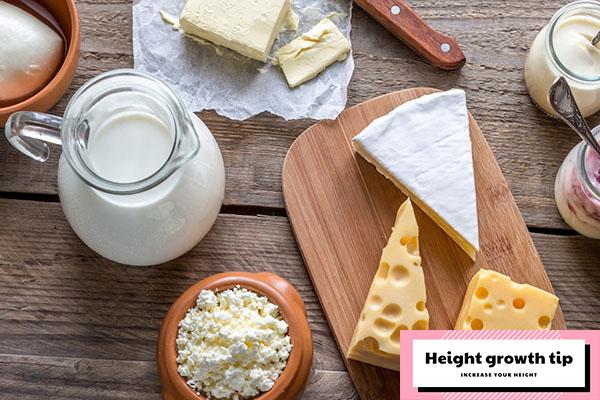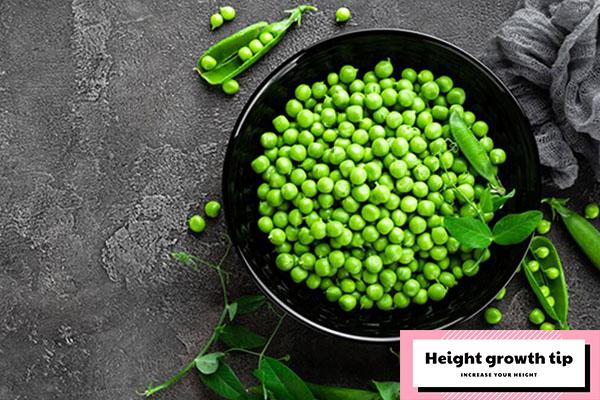Diet is a pivotal factor in meeting calcium requirements. Nutrient-rich foods such as dairy products (milk, cheese, yogurt), leafy green vegetables (spinach, kale), and fortified options (almond milk, cereals) provide essential calcium for height growth. Pairing these foods with vitamin D and other nutrients enhances calcium absorption, maximizing its benefits during critical growth periods.
Milk and Dairy Products:
Milk, yogurt, and cheese are among the most bioavailable sources of calcium, essential for strong bones and overall health. Milk provides a complete profile of nutrients, including casein and whey protein, which enhance calcium absorption. Yogurt offers probiotics, boosting gut health while ensuring optimal calcium uptake. Similarly, cheese, especially hard varieties, delivers concentrated calcium along with vitamin D, vital for bone mineralization.
Fortified dairy products such as vitamin D-enriched milk further support calcium absorption and bone strength, particularly in children and adolescents seeking height growth. Choosing the best dairy products ensures not only the intake of calcium but also essential bone-building nutrients, fostering robust skeletal health throughout life.
Leafy Greens
Spinach, kale, and collard greens are excellent sources of plant-based calcium, making them ideal for individuals with dairy intolerance or those seeking non-dairy calcium alternatives. These leafy vegetables not only provide essential calcium but are also rich in antioxidants, contributing to overall health. Spinach offers 99 mg of calcium per 100 grams, while kale provides 150 mg and collard greens supply 232 mg per the same weight. However, the presence of oxalates in spinach can reduce calcium absorption, highlighting the importance of dietary diversity to optimize nutrient intake.
Including a mix of leafy greens like kale and collard greens in your diet can help mitigate oxalate interference and enhance calcium absorption. Diversifying your intake of these green veggies ensures a steady supply of nutrients while maximizing health benefits. For individuals aiming to boost calcium levels naturally, these height greens provide a nutrient-dense solution to support bone health without relying on dairy.

Nuts and Seeds
Almonds, sesame seeds, and chia seeds are compact nutritional powerhouses that support bone health and overall wellness. These nuts and seeds are exceptional sources of calcium, a mineral critical for strong bones and teeth. Almonds deliver a robust dose of magnesium, essential for muscle and nerve function, while sesame seeds are rich in lignans, which contribute to cardiovascular health. Chia seeds, packed with omega-3 fatty acids, aid in promoting heart health and reducing inflammation.
Additionally, these natural foods provide healthy fats and vital nutrients in concentrated forms, making them ideal for enhancing growth and maintaining nutritional balance. Incorporating them into your daily diet—whether through smoothies, salads, or seed oils—not only boosts calcium intake but also supports the best nuts and seeds for height and growth development. By making almonds, sesame seeds, and chia seeds a dietary staple, you can achieve a simple yet effective way to fortify your diet with essential nutrients.
Tin liên quan: Do leg splits help increase height?
Fish with Bones
Sardines and salmon are exceptional sources of calcium, thanks to their edible fish bones. The soft bones in these species are rich in calcium phosphate, contributing significantly to bone health and preventing deficiencies. For example, a serving of canned sardines can provide up to 35% of the daily calcium requirement, making them a convenient and nutritious option for boosting dietary calcium intake.
In addition to calcium, these fish deliver omega-3 fatty acids, essential for joint health and overall well-being. Omega-3s reduce inflammation and support cardiovascular health, while marine nutrients from sardines and salmon enhance bone strength and growth. These characteristics make calcium-rich seafood like sardines and salmon ideal for those seeking natural, nutrient-dense options to support height growth and robust skeletal development.

Fortified Foods
For individuals who cannot consume traditional calcium-rich foods like dairy, fortified foods provide an effective alternative. Products such as fortified orange juice, soy milk, almond milk, and calcium-enriched breakfast cereals are rich in this essential mineral. These items are not only convenient but also offer a vital solution for meeting daily calcium needs, particularly for those following vegan or lactose-free diets. The fortification process ensures that these foods contain adequate calcium levels, supporting bone health and reducing the risk of osteoporosis.
Choosing fortified foods also simplifies nutritional planning. With clear nutrient labeling, consumers can easily identify the best calcium-fortified options tailored to their dietary preferences. For example, fortified plant-based milks like almond and soy are excellent for vegans, while breakfast cereals provide a versatile choice for busy mornings. These options, combined with a balanced diet, make fortified foods an essential part of modern nutrition.

The Essential Role of a Balanced Diet in Height Growth
A diverse and nutrient-rich diet is crucial for supporting height growth and overall health. Foods high in calcium, such as milk, yogurt, and leafy greens, play a significant role in strengthening bones and promoting bone elongation. Alongside calcium, nutrients like vitamin D and proteins enhance nutrient synergy, aiding in optimal height development. Incorporating these height-increasing foods ensures that the body has the building blocks needed for robust growth.
Consistency in maintaining a balanced diet is equally essential. Regular daily intake of growth-boosting nutrients fosters not just physical development but also sets the foundation for healthy habits. Together, these practices create a sustainable framework for height growth while supporting overall well-being.


